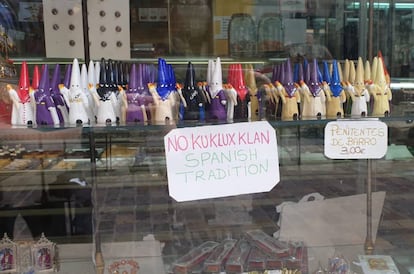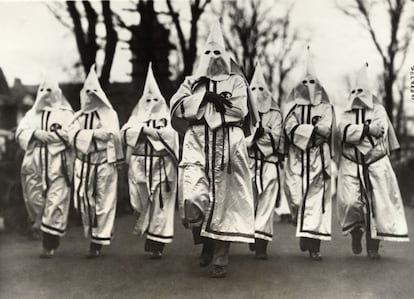¡°No Ku Klux Klan. Spanish tradition¡±
A pastry shop in C¨¢diz selling figurines of hooded penitents has decided to anticipate the uncomfortable questions it usually receives around Easter time

The Confiter¨ªa El P¨®pulo, a pastry shop located 200 meters away from the cathedral in the southern Spanish city of C¨¢diz, doesn¡¯t just sell pastries but also souvenirs, such as ceramic figurines in the shape of hooded Nazarenes or penitents. Raquel Flores has been selling these figurines in the store for the past 10 years. She¡¯s also spent the past 10 years explaining to tourists that they aren¡¯t representations of the Ku Klux Klan, the?white supremacist hate group from the United States.
There are some who know what Semana Santa is about, but there are others who don¡¯t. They look at you as if you¡¯re crazy when they see the figurines Raquel Flores, 33
¡°Many tourists think this. When there aren¡¯t many people in the shop, I show them a video of a procession so they can see the difference,¡± explains Flores, 33, to Verne over the phone. For this year¡¯s Semana Santa, or Holy Week, she opted for a quicker solution. She wrote a sign in English saying: ¡°No Ku Klux Klan. Spanish tradition,¡± and hung it in the window by the figurines.
She put the sign up on April 13. ¡°Many tourists from cruise ships pass by here. There are some who know what Semana Santa is about, but there are others who don¡¯t. They look at you as if you¡¯re crazy when they see the figurines. And it doesn¡¯t only happen with Americans. There are also, for example, Argentines who ask if they represent the Ku Klux Klan.¡±
Her sign has drawn a lot of attention since it went viral on the internet. ¡°I realized when my husband sent me an Instagram post from [online humor page] Cabronazi, in which there was a photo of the sign and of our penitents.¡± The sign has also been widely circulated via WhatsApp, Facebook and Twitter.
¡°We don¡¯t know who took this photo, but there are already plenty of people who have recognized our figurines and told us about it,¡± says Flores. This figurines can be bought for €3 each in the pastry shop throughout the year, but they are only in the storefront during Semana Santa. ¡°They are handmade. The colors change every year depending on the C¨¢diz brotherhoods we wish to represent.¡±
After explaining that they are representations of Semana Santa Nazarenes, many tourists end up buying the figurines, says Flores. ¡°I had one person who bought one thinking they were from the Ku Klux Klan, without giving me time to explain that they¡¯re from Semana Santa. But this has only happened once in 10 years.¡± Her uncle, Manuel Rosas, is the owner of the pastry shop. ¡°We are very used to having to explain that our penitents aren¡¯t racist.¡±
A lasting confusion
It¡¯s not the first time that a tourist out of the million who visit the southern Spanish city has confused the Nazarene robes for those of the Ku Klux Klan. The racist organization is known worldwide, thanks in part to Hollywood movies. Semana Santa traditions are well known in Spain, but not so much to foreigners.
¡°In the United States you need to explain that the hooded figure is not from the Ku Klux Klan,¡± said Spanish Hollywood star Antonios Banderas back in 2011. In 2015, the BBC used an image of a penitent of the San Gonzalo brotherhood in Seville to illustrate an article on the Ku Klux Klan. In 2017, Trent Lockett, the American basketball player, confused the Nazarenes with the Ku Klux Klan and shared it via his Instagram account. And during their first year in Spain in the 1980s, basketball players Joe Arlauckas and Ricky Brown almost ran away from a procession in M¨¢laga, much to the confusion of the penitents.
¡°Above all there is confusion with the penitents who are dressed completely in white,¡± explains Flores, whose idea to hang up a sign is nothing new. Other people have also written similar signs and hung them up around their stores.
#LateHumans pic.twitter.com/YZFe2ebibp
— Humans Of Late Tourism (@LateHumans) April 16, 2019
#LateHumans pic.twitter.com/mCKkug4FMl
— Humans Of Late Tourism (@LateHumans) April 16, 2019
The origin of the clothing
The penitents hoods date back to the Spanish Inquisition. In the 15th century, it was decreed that those convicted of religious crimes had to wear the conical hoods so that everyone knew they had sinned. This symbol of imposed penitence from the Inquisition was later translated into processions. While we don¡¯t know for sure, their first use in processions could date from 17th-century Seville. The color of the robes depends on the brotherhood, which is why there are purple, red and white ones.

The Ku Klux Klan was born centuries after the first use of these hoods in Spain. The organization originated in the 19th century after the Confederate defeat in the Civil War, but there is no clear reason for their chosen attire. There are theories that they wore these hoods after being inspired by the 1915 movie The Birth of a Nation, which drew from illustrations of the 1905 book The Clansman, which is a work of reference for white supremacists. The garments in these works inspired leaders of the organization, such as William J. Simmons, who consolidated these robes among his followers. Another theory comes from historian Arturo Alfonso Schomburg, who in 1927 stated that the Seville Brotherhood of the Negritos was one of the possible sources of inspiration for the Ku Klux Klan.
English version by Asia London Palomba.
Tu suscripci¨®n se est¨¢ usando en otro dispositivo
?Quieres a?adir otro usuario a tu suscripci¨®n?
Si contin¨²as leyendo en este dispositivo, no se podr¨¢ leer en el otro.
FlechaTu suscripci¨®n se est¨¢ usando en otro dispositivo y solo puedes acceder a EL PA?S desde un dispositivo a la vez.
Si quieres compartir tu cuenta, cambia tu suscripci¨®n a la modalidad Premium, as¨ª podr¨¢s a?adir otro usuario. Cada uno acceder¨¢ con su propia cuenta de email, lo que os permitir¨¢ personalizar vuestra experiencia en EL PA?S.
En el caso de no saber qui¨¦n est¨¢ usando tu cuenta, te recomendamos cambiar tu contrase?a aqu¨ª.
Si decides continuar compartiendo tu cuenta, este mensaje se mostrar¨¢ en tu dispositivo y en el de la otra persona que est¨¢ usando tu cuenta de forma indefinida, afectando a tu experiencia de lectura. Puedes consultar aqu¨ª los t¨¦rminos y condiciones de la suscripci¨®n digital.











































